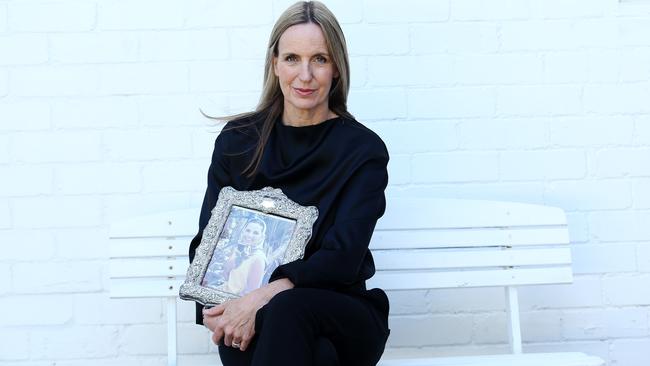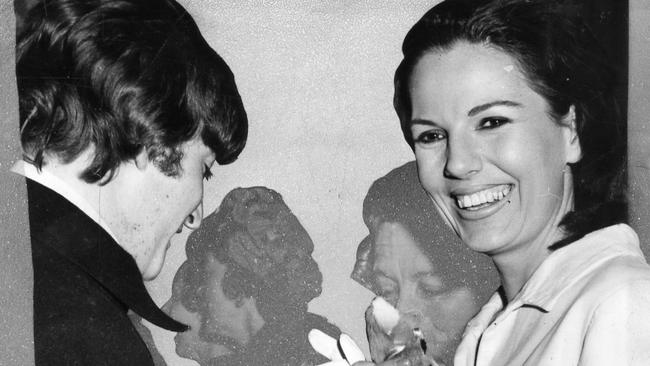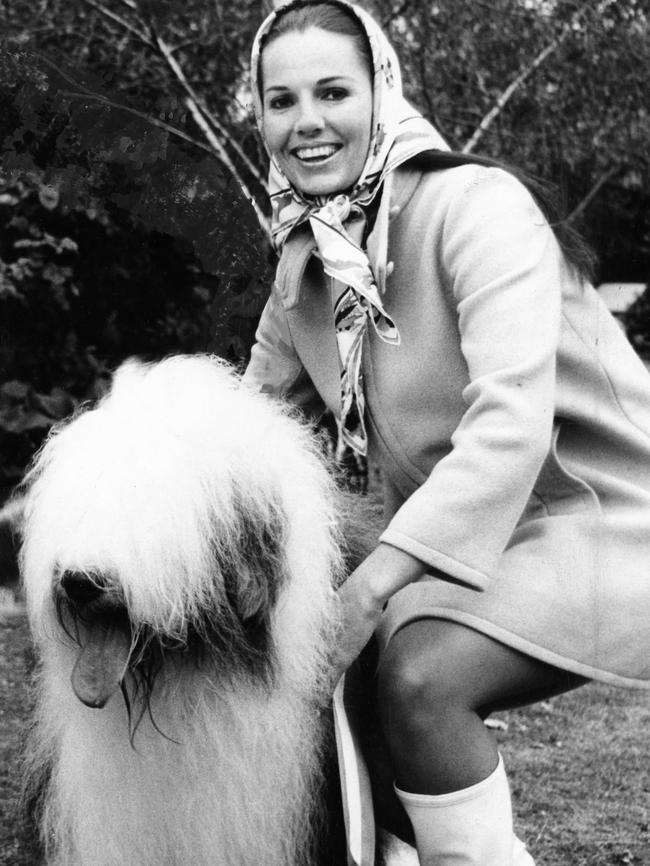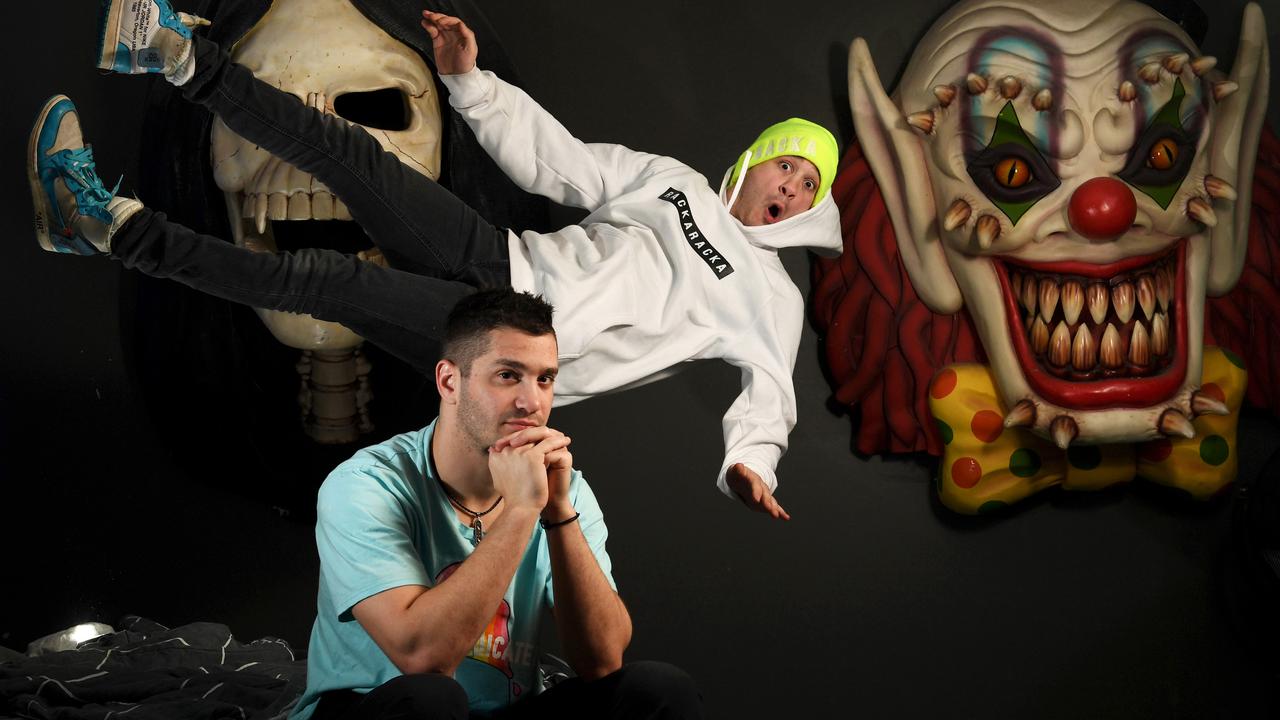Remembering Julie Bonython – Adelaide’s queen bee
BEAUTY queen, decorator, fashionista, blunt speaker – Julie Bonython was doyenne of SA’s social set for decades. And, as long as you weren’t a Catholic priest, she was the hostess with the mostest.

SA Weekend
Don't miss out on the headlines from SA Weekend. Followed categories will be added to My News.
JULIE Bonython didn’t do casual. “I never saw my mum in a tracksuit ever – she was always ‘dressed’,” Nicole Bonython-Hines recalls of her immaculately groomed late mother, who even managed to make doing the housework a glamorous occasion.
“I remember Mum doing the vacuuming in her high heels all the time... she always had her high heels on,” she says.
Even in her later years when living with dementia in a nursing home, before her death at age 80 in September, Julie had standards.
“She would get totally dressed – with the jewels and the dress and everything – and then she would go back and sit on her bed.”
The well-known wife of entrepreneur Kym Bonython, who was farewelled with a state funeral when he died in 2011, Julie also came from an establishment family in the halcyon days of wool.
The eldest of Tess and Jim McClure’s five children, Julie was born Julianne Margaret McClure in 1936.
“She was the apple of her parents’ eye who could do no wrong, (was) always very pretty and good fun, even as a kid,” Bonython-Hines says.
In 1954, Julie made her debut and went on a “finishing” tour of Europe attending Royal Ascot where she was photographed and featured in the British press.
Working as a kindergarten teacher on her return, she married Kym Bonython in 1957 and had three children – Tim, Michael and Nicole.
In the ’60s, her natural good looks were enhanced by frequent visits to beauty parlours with toddler Nicole in tow. “I remember the hours ... it felt like hours but it probably wasn’t ... sitting in front of the mirror with the lashes and the big hair,” Bonython-Hines says.
“I think that’s my first memory of her – sitting at her make-up table, getting ready.”
By the time Julie was in her teens the McClures lived in the Adelaide suburb of St Georges. A champion tenpin bowler and whiz on water skis – tricks and all – she was popular with Adelaide’s social set long before she was crowned Miss South Australia in 1956. “Because she was so pretty there were always swarms of boys (at the house) and it was her brother Murray’s job to try and keep them all away and make excuses for her when she snuck home in the middle of the night,” Bonython-Hines recalls.
While preparing a eulogy for her mother she was surprised to discover that the beauty queen had a tomboy past.

Growing up on a sheep station in Wilcannia in far west New South Wales – the family also had a house in Broken Hill – Julie, was “always climbing trees” and had an affinity with the local Aborigines.
“They taught her how to catch witchetty grubs and yabbies, and all these proper bush techniques,” Bonython-Hines says, adding: “Apparently she was an ace shooter – no one could shoot as straight as her.”
The latter would, no doubt, amuse those who knew and loved Julie for being a straight shooter, often outspoken to the point of being blunt. “Everybody would agree there’s just been nobody like her and there probably won’t be again,” Bonython-Hines says. “I think that was a time when that kind of personality could happen.
“I don’t think you could get away with being like her these days in a world of PC.” Julie was not one to entertain the “if you can’t say anything nice don’t say anything at all” unspoken rule and loved giving advice – “unsolicited, of course”.
“When she would say something that wasn’t complimentary, she was usually right. You know, ‘You shouldn’t wear that colour’ and it would be totally true,” Bonython-Hines says, adding: “She would go into someone’s house and go, ‘Oh, no, no, that’s all wrong – that piece shouldn’t be there, you should move that to there’ and she would have no qualms about saying stuff, but she was always right.”
Her flair for interior design – Julie styled houses for a number of friends – was also on display in her quarters at the nursing home, which she loathed, but resided for the last six years of her life. Bonython-Hines suspects her dislike was mostly because of its aesthetics. “She decorated her room and it was amazing,” she says. “It was like going into a magical world, when you looked at how bland everybody else’s was and then you looked at her room with paintings on the wall and touches …”
Bonython-Hines, who is a fashion stylist, has inherited Julie’s eye for detail. But she says she envied her mother’s spontaneity compared to her own “much more considered” approach.
“When I was living in Sydney and I was in this rental (house) with a typical sort of Italian garden – fruit trees everywhere, a vegie patch and no flowers – I went out somewhere and when I came back there was this incredible arrangement in the middle of the table made up of branches and different things,” Bonython-Hines says.
“She had just thrown this stuff together that had been in my garden the whole time ... and it totally transformed the room.”
Julie’s inventiveness extended to the kitchen. “Mum could open the fridge and grab whatever was in there and create some fabulous meal out of it whereas I systematically have to follow a recipe … I’m a great cook as long as I’m following a recipe. Mum was a great cook – she was just really naturally creative.”
With a reputation for being Adelaide’s hostess with the mostest – welcoming The Beatles to Adelaide in 1964, for example – Julie always made sure guests enjoyed “the right drinks and food” in an “immaculate” setting.
She also did her own catering when entertaining leading artists and jazz greats, unless it was a particularly large gathering in which case she would entrust the hired help to take care of the nibbles only. “I remember being little and sneaking into the bedroom and loving the sound … that dense (hum) of adults talking,” Bonython-Hines says of the frequent dinner parties.
“Mum was renowned for her parties. If any of her friends were having some kind of a party she would take over and organise it all for them and they’d be happily receiving the advice and help.”
Fundraising and modelling for charities, Julie was also a fashion plate. “She had a pretty fabulous wardrobe. That is probably where my whole interest in fashion started,” Bonython-Hines says. “I remember fossicking through her wardrobe and there would be some pretty great designers – Pierre Cardin and (André) Courrèges – people significant and iconic.
“In the ’70s she had Oscar de la Renta and Geoffrey Beene. She bought well.”

That same decade, Julie opened a boutique in North Adelaide stocking her business partner Carla Zampatti’s eponymous label and other luxury brands. By the ’80s, like every woman who was anyone in Australia, she was dressed by George Gross and Harry Who. Designers George and Harry were in Julie’s circle, which included lifelong friends such as the late Margaret Fricker and Margaret Brown, Bardie Simpson and Pam Cleland.
Another close friend, the late Anne Kidman, the grandaughter of legendary pastoralist Sir Sidney Kidman and also Bonython-Hines’s godmother, was the catalyst for what was to become one of Adelaide’s greatest love stories when she introduced Julie to Kym, an art dealer, jazz impresario and racetrack promoter.
“I think Dad liked beautiful things – women included – and I think she was swept off her feet,” Bonython-Hines says.
“He was 16 years older than her ... so all those other boys didn’t stand a chance once Dad came onto the scene. (When Dad died) she really missed him and spoke of him often, proudly telling all and sundry of his accomplishments.”
Julie was, as Bonython-Hines says, the queen bee of Adelaide’s social set. “Lots of people aspired to be like her – she was always getting the house photographed in Vogue Living and Belle.” And just as Julie’s controversial comments would elicit “oohs”, the home she made with Kym, an avid art collector, at Eurilla in Mt Lofty was the talk of the neighbourhood.
“There were paintings everywhere – in fact Mum used to complain that there was no spare space on the walls – you couldn’t appreciate one item because bang next to it there was something else. I think Dad couldn’t help himself,” Bonython-Hines says.
“There were some kids who lived up the road who weren’t allowed to visit because there were too many naked women in the house … and there was this thing in the hallway by (British ’60s/’70s pop artist) Allen Jones, a seven-foot-eight fibreglass naked woman in bondage and it was a hatstand … which was the first thing you saw and it was pretty full-on.”
While she lamented the lack of wall space, Julie “loved it all” and was utterly devastated when Eurilla burnt to the ground in the 1983 Ash Wednesday fires.
“When the firemen arrived they pulled out what was in the front hall, so there was a table, some photos in frames and the John Brack portrait of Dad that is now hanging in the portrait gallery in Canberra. And that was pretty much it.
Literally everything went,” Bonython-Hines says. “It had previously been my grandmother’s house so there was a lot of stuff that was heirloom as well – the silver and beautiful paintings from her and amazing mahogany furniture.”
The neighbouring caretaker’s cottage had been spared, so Kym and Julie moved in while they decided what to do.

“It must have been pretty awful living in this little house totally surrounded by charred everything,” Bonython-Hines says, adding that while her parents chose to rebuild, her mother never really recovered from the trauma. “In a way that gave her a project, but I think it scarred her forever. Unfortunately, she didn’t have the capabilities to manage the tragedy ... she just never recovered from (the fire).
“Maybe having such a blessed life was not such a good thing ultimately for her ... the more adversity you have the better you get at dealing with it. She was very protected by being the adored child and then being the adored wife.”
While she may have had a blessed life, marrying Kym in 1957 crossed a line as far as the Catholic Church was concerned. And after she crossed it, Julie dug her heels in. “It was quite controversial because my grandparents were Catholic and quite a significant Catholic family. When Mum wanted to marry a divorced Anglican it was a big drama,” Bonython-Hines says. “She got excommunicated, apparently. She was told she could go to mass, but she couldn’t take communion. I think that was a bit of a blow for her so she never went to church again.”
The day before she died, Julie’s sister organised for a priest to visit and bless her.
“She was pretty much unconscious and he leant over to put the oil on her forehead and she opened her eyes and she couldn’t really talk ... she went (growl) and then he tried to do to it again and she went (growl),” Bonython-Hines says.
“Mum’s sister, was saying ‘Come on Julianne, Mum and Dad would love this if you do this and it’s not going to hurt or anything’ and Mum just looked at her and said ‘shut up’. (She) hadn’t spoken a word (for some time), but she was very clear she wasn’t going to be blessed by a Catholic priest. So it didn’t happen.”
As bold as she was beautiful, Julie was a straight shooter to the last. ●



